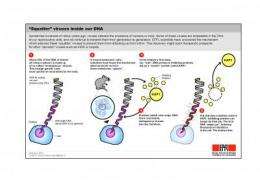The viruses within -- and what keeps them there (w/ Video)

It is known that viral "squatters" comprise nearly half of our genetic code. These genomic invaders inserted their DNA into our own millions of years ago when they infected our ancestors. But just how we keep them quiet and prevent them from attack was more of a mystery until EPFL researchers revived them.
The reason we survive the presence of these endogenous retroviruses—viruses that attack and are passed on through germ cells, the cells that give rise to eggs and sperm—is because something keeps the killers silent. Now, publishing in the journal Nature, Didier Trono and his team from EPFL, in Switzerland, describe the mechanism. Their results provide insights into evolution and suggest potential new therapies in fighting another retrovirus—HIV.
By analysing embryonic stem cells in mice within the first few days of life, Trono and team discovered that mouse DNA codes for an army of auxiliary proteins that recognize the numerous viral sequences littering the genome. The researchers also demonstrated that a master regulatory protein called KAP1 appears to orchestrate these inhibitory proteins in silencing would-be viruses. When KAP1 is removed, for example, the viral DNA "wakes up," multiplies, induces innumerable mutations, and the embryo soon dies.
Because retroviruses tend to mutate their host's DNA, they have an immense power and potential to alter genes. And during ancient pandemics, some individuals managed to silence the retrovirus involved and therefore survived to pass on the ability. Trono explains that the great waves of endogenous retrovirus appearance coincide with times when evolution seemed to leap ahead.
"In our genome we find traces of the last two major waves. The first took place 100 million years ago, at the time when mammals started to develop, and the second about fifty million years ago, just before the first anthropoid primates," he says.
The discovery of the KAP1 mechanism could be of interest in the search for new therapeutic approaches to combat AIDS. The virus that causes AIDS can lie dormant in the red blood cells it infects, keeping it hidden from potential treatments. Waking the virus up could expose it to attack.
Provided by Ecole Polytechnique Fédérale de Lausanne















